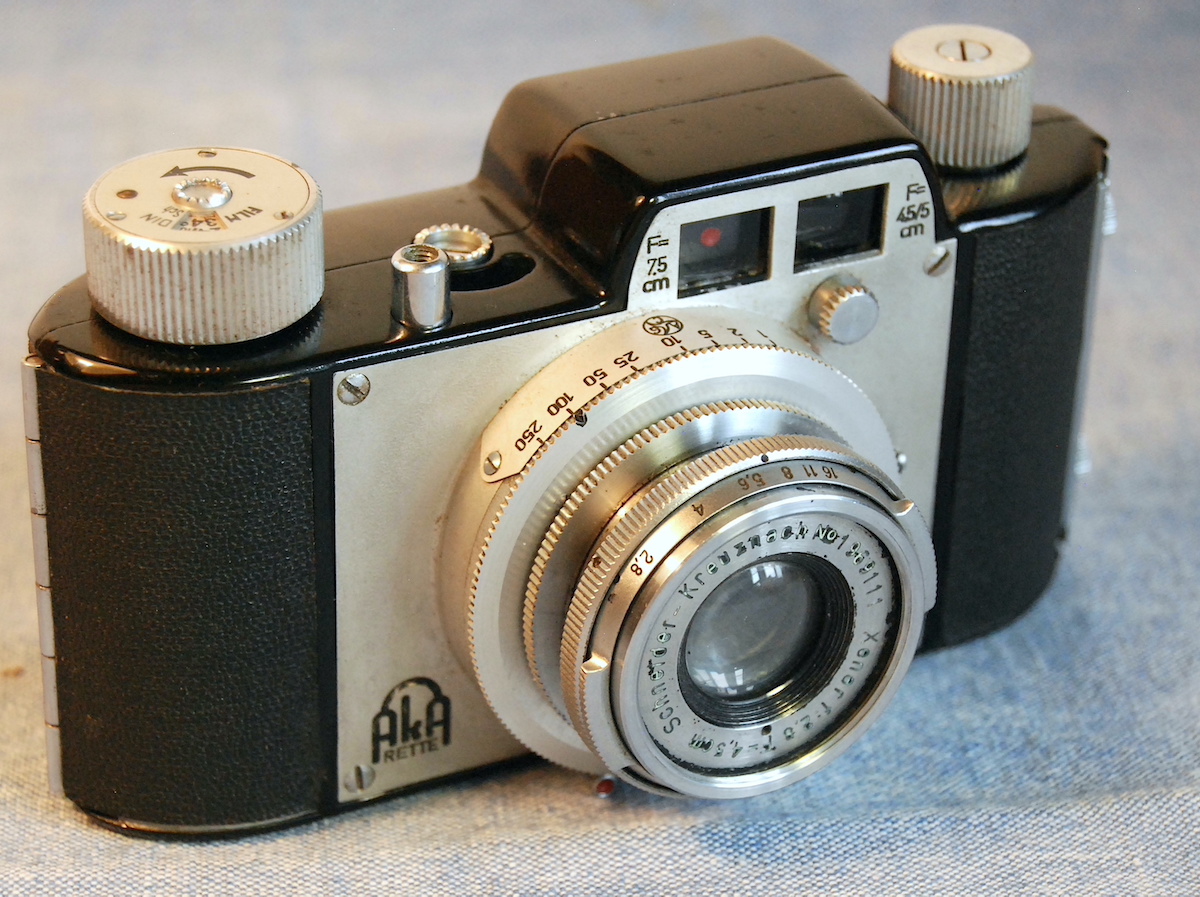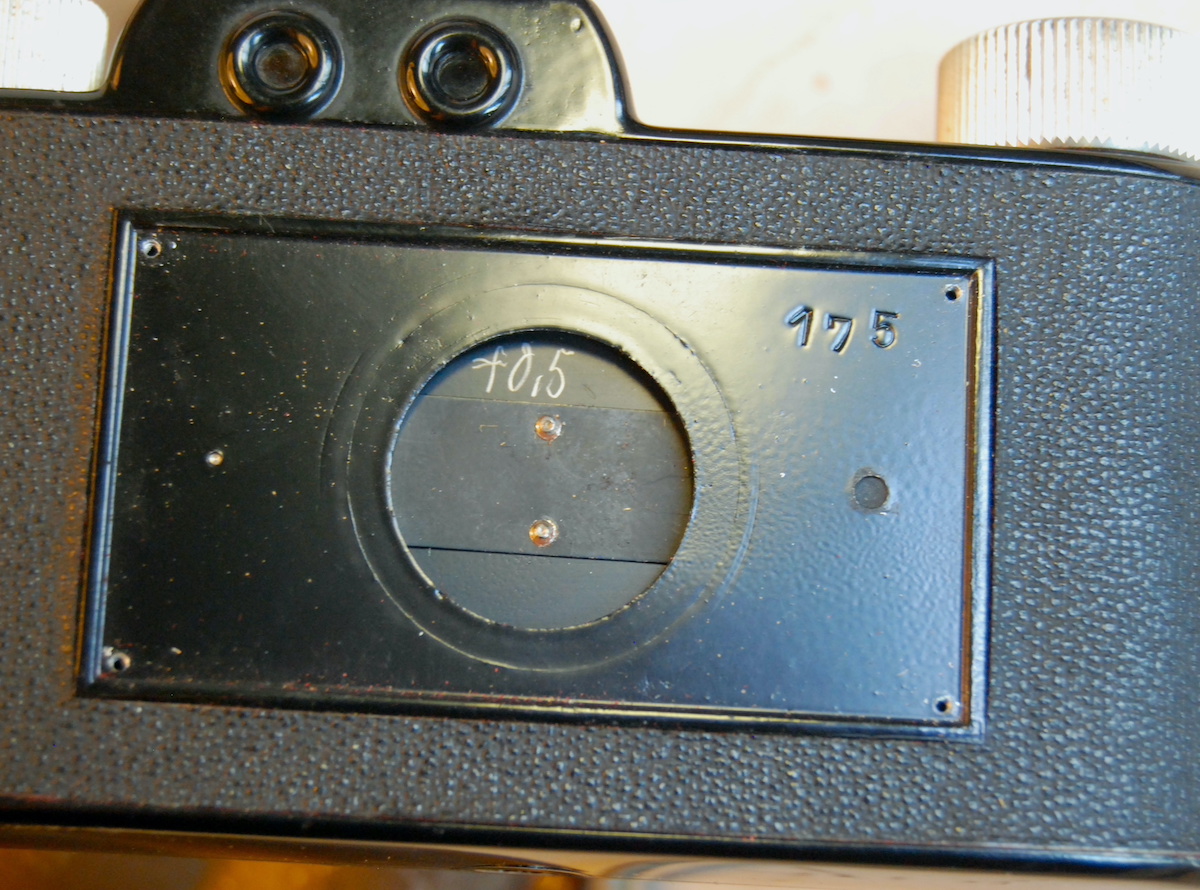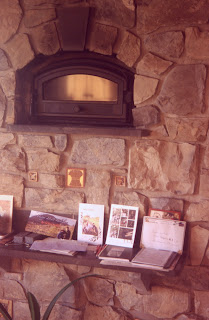 |
Lordomat standard types 2 and 3 with 50mm f2.8 and 50mm f1.9
|
History: The Leidolf company was founded in 1921 by Rudolf Leidolf in Wetzlar, Germany. Leidolf had trained as a “precision mechanic” at Henson & Son. He was later joined by his son-in-law, Fritz Meinhardt, who had also trained as a precision mechanic for E. Leitz. The company started business machining parts for microscopes for Leitz. Meinhardt would in time take over management of the company and he may have been responsible for many of the camera designs.
Leidolf got into manufacturing cameras after World War II (starting in 1948-49) along with many other optical firms trying to take advantage of the high post-war demand for German cameras. Its first camera were a simple, metal-bodied cameras called a Leidox that used 127 size film. Leitz did not like that name and under threat, Leidolf changed the name to Lordox. Following popular trends, the company turned to a 35mm version in 1952.
 |
Notice of Lordomat sold by Widina, 1953.
|
|
In 1953, Leidolf announced a new 35mm camera with a behind-the-lens Gauthier Prontor shutter and offering complete interchangeability of lenses. This became the Lordomat “standard.” It was supplemented by the more sophisticated Lordomat C35(luxus) with an additional finder and a built-in meter in 1956. Leidolf would later produce many different versions of their camera that would use the same basic body-shape, layout and controls. Some, such as later Lordox, had non-interchangeable lenses. Other versions included built-in light meters and bright-frame finders. The company ceased camera production in 1962 but lingered on as a part of Wild Heerbrugg before disappearing into the Leitz Holding company in 1990.
* For a through review and many images of the different models, I recommend Cees-Jan de Hoog’s website <http://www.cjs-classic-cameras.co.uk/leidolf/leidolf.html> Mike Eckman also has an excellent review of a Lordomat in his series on older cameras <https://www.mikeeckman.com/2015/11/leidolf-lordomat-1953/>. For a detailed and accurate history of the Leidolf company. I recommend the December 15th, 1998 issue of Photographica Cabinett which is totally devoted to a history of the Leidolf company and its cameras.
Leidolf does not appear to have ever manufactured anything for their cameras other than the bodies—with the possible exception of their 35mm finder. Other accessories came from Wedena in Bad Nauheim.
Wedena was a marketing firm founded by Willi Diehl. Originally a company called “Widina” for Willi Diehl Nauheim, it served as the exclusive sales department and marketer for the Leidolf cameras. All the German advertising and even the camera instructions identify Wedena as the company responsible for the Leidolf cameras. Wedena also marketed other photographic products such as the Taco Universal flashgun which was actually manufactured by Erich Kaiser. The Lordomat’s turret finder, filters and closeup lenses all bore only the Wedena name.
Wedena based its sales strategy on getting major mail-order and photo supply companies to sell the Leidolf products instead of working to get the Lordomats into specialty stores. Starting in 1957, most of the German sales were made through Foto-Quelle, part of a huge warehouse-catalogue-sales chain that in 1970 would claim to be “The largest retailer in the world.”
 |
Quelle ad for C35
|
The Leidolf camera sold throughout Europe, including England, but breaking into the critical North American market proved more difficult. Initially several small, New York based firms picked up the franchise, but none appear to have lasted long. In March 1955 the Minifilm Corp is listed as selling the Lordomat. By September 1956, Royal Photo Distributors are the “Sole Agent.” By May, 1957, Camera Import Corp. was handling sales. In 1958. Montgomery Ward was claiming “Exclusive import rights and sales” for the Lordomat. To do this, the major catalogue company added less expensive versions of the Lordomat with an “Adams” label. In 1959, importation would shift to Unimark Photo, Inc. which added its name to the cameras.
This outsourcing of marketing and dependence on catalogue sales was to prove fatal. With Japanese camera sales growing in the United States and a shift in public demand to single-lens reflexes, companies like Wards and Foto-Quelle insisted on lower and lower prices in order to maintain sales. By 1962, margins had narrowed to the point that Leidolf could no longer make money. When Meinhardt, now the company’s president, refused Foto-Quelle’s latest demands, Foto-Quelle cancelled the contract and, with no German market, Leidolf stopped manufacturing cameras and most of the workers were let go. Rudolf Leidolf and Fritz Meinhardt both died in 1964.
 |
Cover for Wedena & Royal Photo Importers
|
All of the Lordomat’s lenses came from two small optical firms: Enna Werk in Munich and Albert Schacht in Ulm. Both companies manufactured a wide range of lenses in a variety of focal lengths and in a various mounts, particularly in the M39 and M42 thread and in the Exakta mount.
Enna supplied the Lordomat’s normal lenses, either a 50mm f2.8 Lordonar or a 50mm f1.9 Lordon. It also made a 35mm f3.5 Lordonar and a 90mm f5.5 Telordon plus others. Schacht made a 35mm f3.5 Travenar/Travetar, a 90mm f4 Travenar and a 135mm f4 Travenar. Except for the Lordon, all were four-element optics.
A three-element 50mm f2.8mm Triplon in the Lordomat mount was sold with the cheaper Adams camera and also appeared on the non-interchangeable Lordox and other Leidolf cameras.
The Lordomat standard came in three versions. All three featured a Prontor SVS shutter with speeds to 1/300th of a second and included a self-timer. The first shutter type used the old progression of speeds and did not have click stops. Later versions use the modern speed progression, have click stops and feature a button that needs to be depressed to shift the flash sync/self-timer setting.
The first version of the camera has an orange-red film over the rangefinder window. It is the least common version. It also came with a smaller 50mm f2.8 with a chrome front and taking a 34mm filter size. By 1955, the red filter for the rangefinder window was gone and a larger normal lens taking 40.5mm filters was standard. In the third version, strap lugs were added. Otherwise, all three versions are alike.
The first impression one gets is that this a simple, compact camera with clean lines. The wide-based rangefinder and the symmetry of the front with its centered lens mount and equal-sized windows give it balance and helps the handling. The clean top—with all controls except the counter/rewind knob set into the surface—is attractive. The viewfinder is a simple optical finder but bright and clear. No parallax correction. The rangefinder patch in the ones I have seen is bright with a yellowish tinge. The double stroke, reverse wind advance lever is different but easy to get used to. The back comes off with a turn of a bottom lock. Tripod socket and accessory shoe are both centered. Lenses exchange via a threaded collar that fits over a male thread on the body. A notch and pin allow alignment. A simple design similar to the mountings also used by the Akarette/Akarelle and the Diax cameras.
 |
The Lordomat lens mount.
|
Film loads with a reverse curl, but I find the slot on the take up spool difficult to work with and don’t trust the film is advancing correctly until I have observed the rewind turn with an advance. The film counter sets below a plastic-covered window. In almost all cases, the plastic has turned yellow, even a dark orange, making the frame numbers difficult to read.
Removing the top requires only a set of screwdrivers and a spanner wrench. Be careful. A tiny bead acts as a click stop for the film reminder built into the rewind knob. The socket for the rewind may contain tiny brass shims. Two of the Lordomats I handled have their rangefinders off vertically. There is a way to adjust, but it is not easy. The weakest part of the camera is probably the return for the film advance. A wire loop attaches to the capstan and, in turn, connects to a spring that extends half the width of the camera’s top interior. If the wire breaks, the advance lever has to be manually pushed back to the front. I fixed this using 10 lb. monofilament fish line with super-glued knotted loops at each end. Seems to be working for now.
German leaf shutters, Compur or Prontor, all seem to have problems with sticking and slow speeds getting too slow. The Lordomat shares this problem. Exercise and application of lighter fluid seems to help, but keep shutter the blades clean. Focus and aperture rings on my normals and wide angles all seem to be fine, particularly the 50s which still turn smooth as silk. The Schacht telephotos I own had stiff focus and in two cases were completely frozen. Hair dryer heat and lighter fluid got them working again, but focus remains rough.
Final observations: This a camera I find a pleasure to shoot with. The low profile, compact size and easily-set controls are strong points. Despite an all-metal construction, the camera does not feel too heavy. Lens controls are easy to set and on the 90 and 50mm f2.8, f-stops click into place with precision. All but the early Lordonars take readily-available 40.5mm filters and hoods. In tests, I particularly like the 50mm Lordonar and the 50mm Lordon. Schacht lenses have a mixed reputation, but the 35mm Travetar performs well. I am not impressed with the 135mm Travenar.
Because it was imported into the United States, Lordomats show up in this country on ebay regularly, but prices tend to run higher than my budget will allow. These are good cameras and both users and collectors like them. The accessory lenses are harder to find and finding ones in usable condition may be difficult. If you are looking for a easy-to-use 1950s rangefinder 35, you might want to consider a Lordomat.
 |
Two 35mm lenses, Travenar & Travetar with cases
|
























